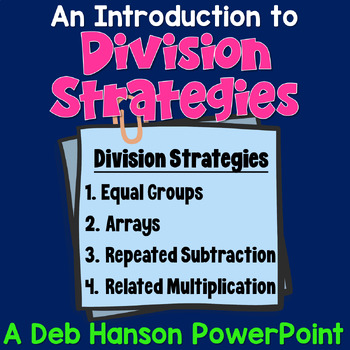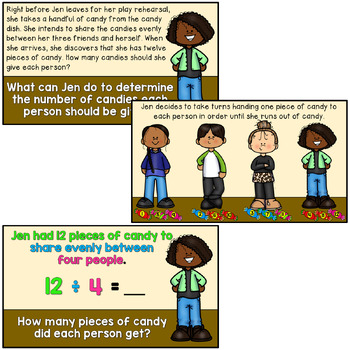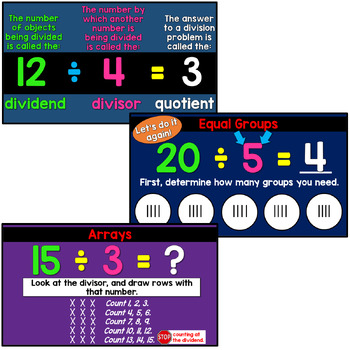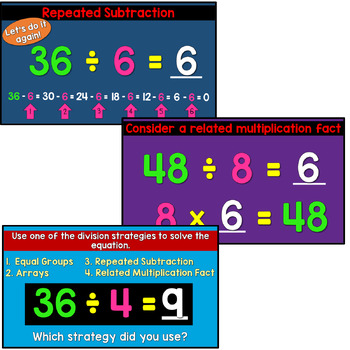Introduction to Division Strategies PowerPoint Lesson with Practice Exercises
- Zip
What educators are saying
Also included in
- This introduction to multiplication bundle has everything you need to introduce basic division strategies to students who are just being introduced to division. The activities in this math bundle make learning how to divide fun and easy! Four multiplication strategies are presented: equal groups, arPrice $7.00Original Price $9.75Save $2.75
Description
Are you searching for a step-by-step PowerPoint that can be used to introduce division strategies to your students in a way that will grab their attention? You've come to the right place! This 31-slide PowerPoint begins by presenting a scenario in which division needs to be used to divide candy into equal groups. Also, division terms are presented and equations are labeled with dividend, divisor, and quotient. Then, four common division strategies are introduced: equal groups, arrays, repeated subtraction, and using related multiplication facts. After each strategy is introduced, four practice opportunities are provided so that students can immediately practice each strategy for themselves.
PowerPoints filled with visuals are ideal for teaching new content to students because PowerPoints tend to be highly engaging and concepts can be easily broken down into understandable chunks of information. But let's face it... they are so time-consuming to create! Fortunately, now you have an option of using one that is already complete, kid-tested, and ready to go for you!
HERE'S THE SEQUENCE OF TOPICS COVERED IN THIS POWERPOINT:
Slides 1-8: Introduction to Division
Slides 8-13: Equal Groups
Slides 14-19: Arrays
Slides 20-25: Repeated Subtraction
Slides 26-31: Using Related Multiplication Facts
This PowerPoint includes a matching 4-page companion handout. Students can write on the handout, recording answers, as they progress through the PowerPoint.
Check out the PREVIEW!!
Here's what teachers like you have to say about this math PowerPoint:
⭐️ Samantha C. said, "This was a great introduction to division. Students enjoyed having the visual and the worksheet to go with it to help them learn to divide using a variety of strategies."
⭐️ Jacklyn K. said, "I absolutely love this resource! I was able to break the PPT into multiple lessons so that I could focus on one strategy before having the students solve using multiple strategies. The animations make it so easy to use and the visuals definitely help with teaching division to 3rd graders!
⭐️ Renae K. said, "This PowerPoint was AWESOME! It allowed me to read the slide to the class, but the graphics included allowed the students to "see" how to solve division problems. This was how I introduced division to my third graders! It is a great resource that I will continue to use each year!"
⭐️ Elen E. said, "This was a great resource!! I had students who were completely lost able to grasp the division concept and were answering questions correctly!!!"
Looking for follow-up activities? Check out the following:
Division Craftivity: Dividing Bubble Gum Equally
If you are interested, I have an Introduction to Multiplication Strategies PowerPoint that parallels the layout of this PowerPoint. Check it out HERE.
Please note: You DO have my permission to convert this PowerPoint to Google Slides, and to share it with your students via Google Classroom. (A Google link is not provided, but you may upload the PowerPoint to Google yourself, if you wish.)
Also, the PowerPoint cannot be edited due to the copyright requirements made by the contributing artists (clip art, font, backgrounds).
Copyright by Deb Hanson
This item is a paid digital download from my TpT store
www.teacherspayteachers.com/Store/Deb-Hanson
This product is to be used by the original downloader only. Copying for more than one teacher is prohibited. This item is also bound by copyright laws. Redistributing, editing, selling, or posting this item (or any part thereof) on an Internet site that is not password protected are all strictly prohibited without first gaining permission from the author. Violations are subject to the penalties of the Digital Millennium Copyright Act. Please contact me if you wish to be granted special permissions!






